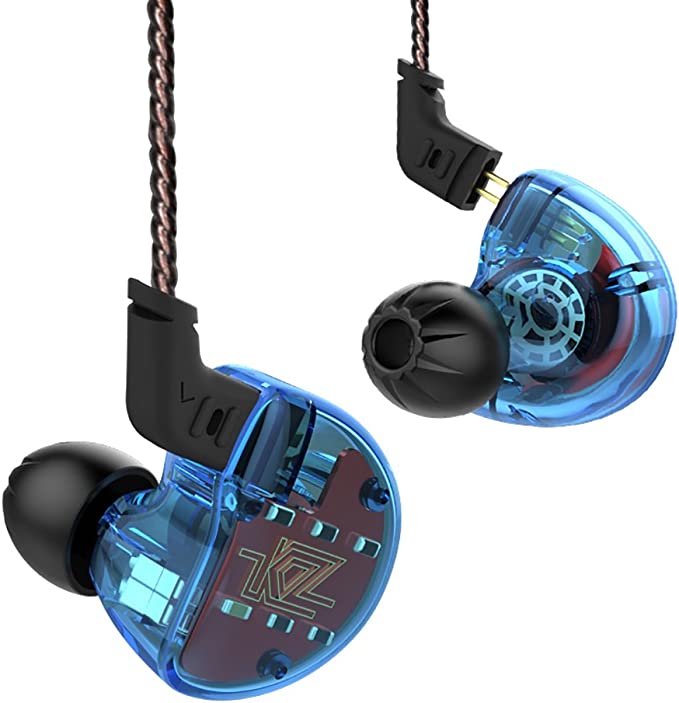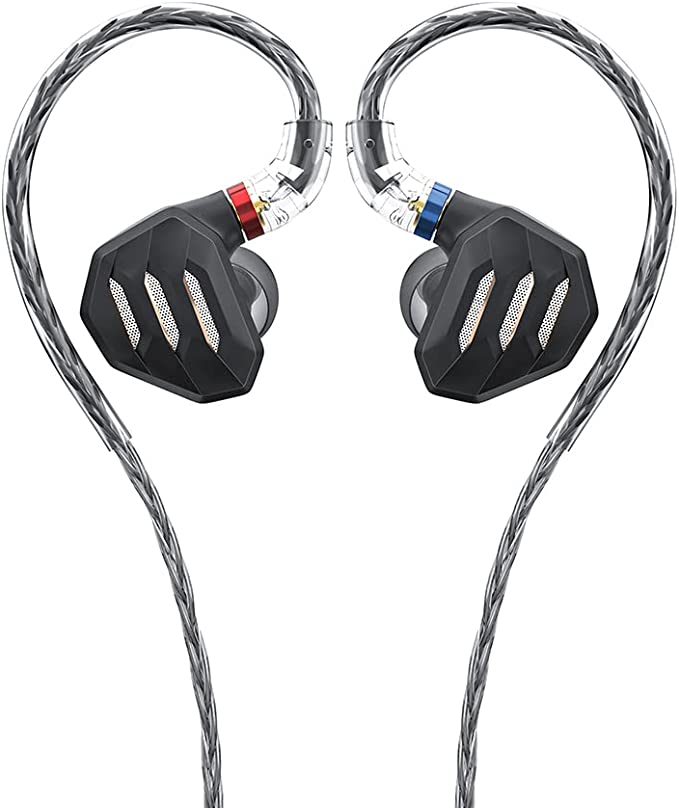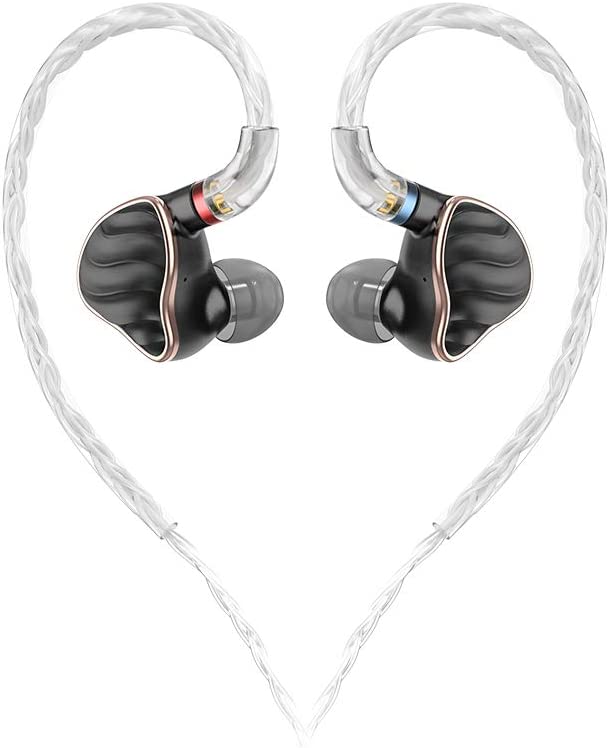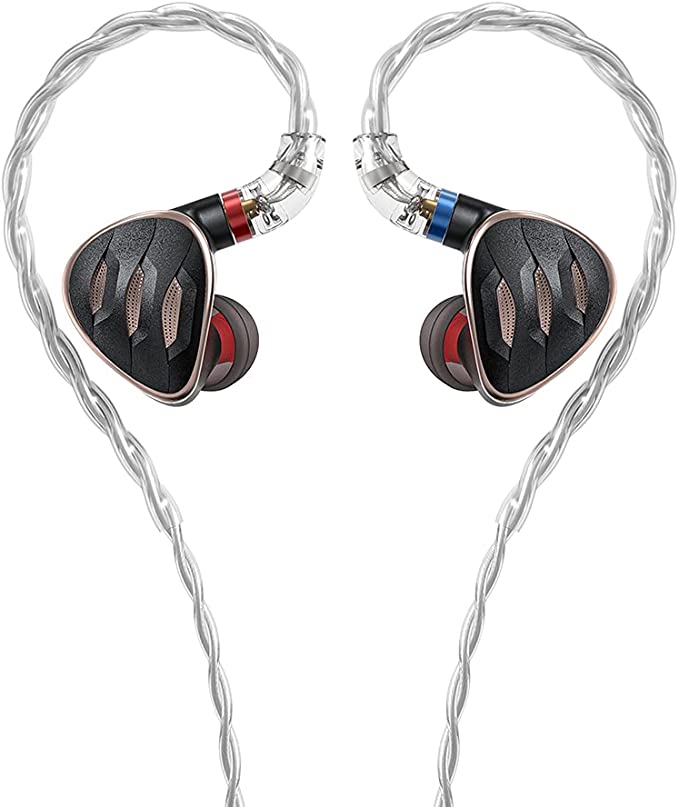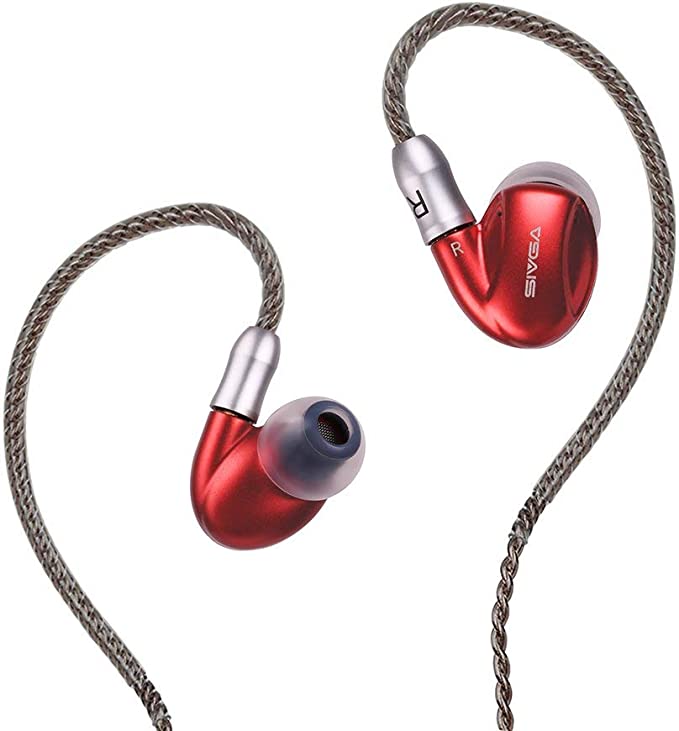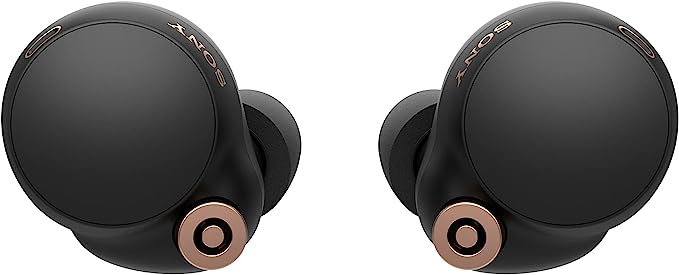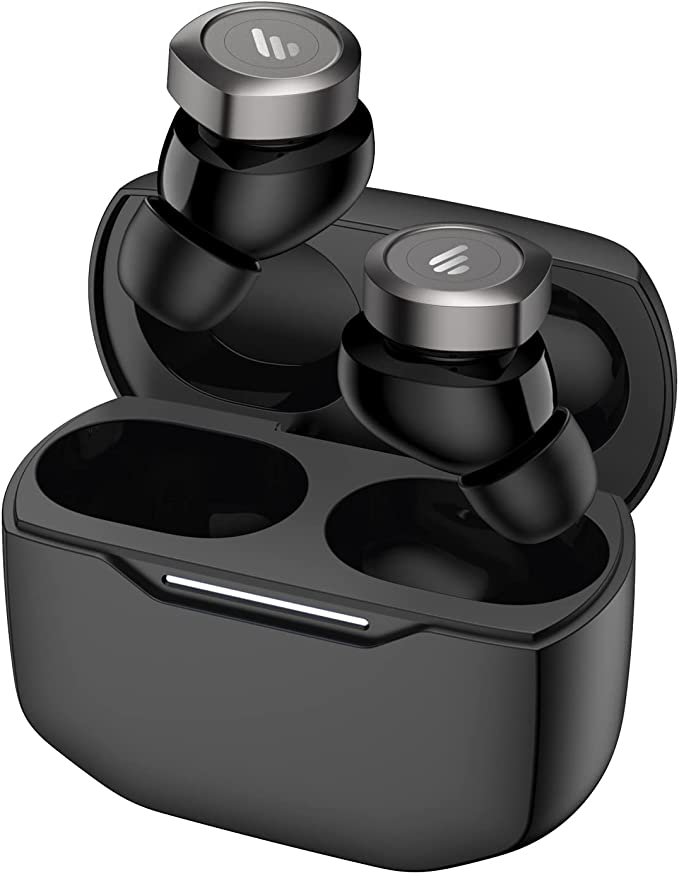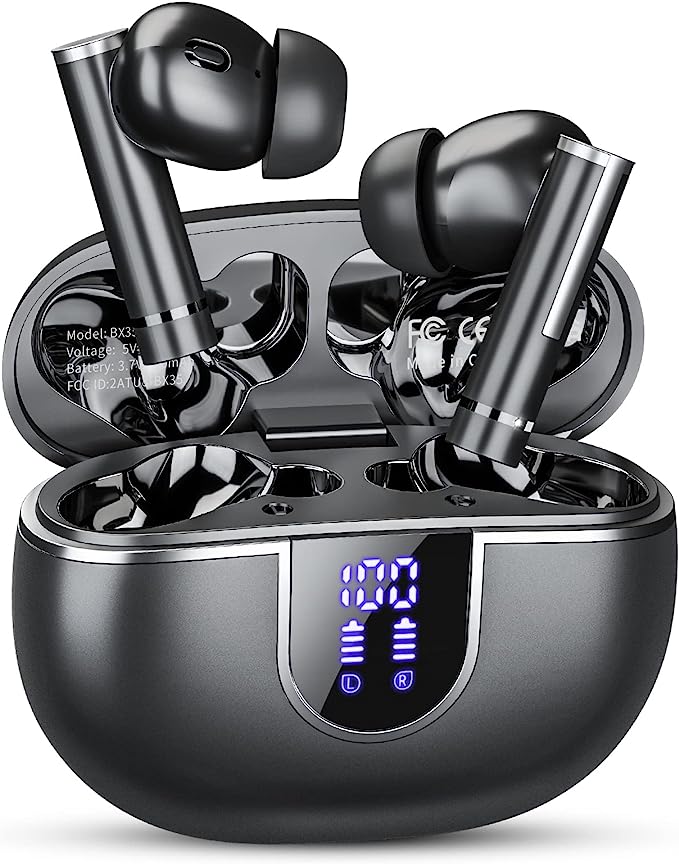canpur JF1&1 IEM in Ear Monitor Earphones – Recommended for Musicians
Update on June 25, 2025, 4:32 p.m.
In the bustling soundscape of modern life, the desire for a personal oasis of sound has led many to the intimate world of In-Ear Monitors, or IEMs. These marvels of miniaturization promise a concert hall experience nestled directly within your ears. Among the myriad options, the canpur JF1&1 IEM 1BA+1DD in Ear Monitor Earphones emerge as an intriguing contender, offering a blend of established audio technologies and modern manufacturing techniques, all seemingly wrapped in an accessible package. But what’s truly happening inside these small shells, and how does the science translate to what you hear and feel?

The Heartbeat of Sound: Unpacking the 1BA + 1DD Hybrid Symphony
At the core of any earphone lies its “driver” – the tiny engine that converts electrical signals into the sound waves we perceive. The canpur JF1&1 employs a “hybrid” system, pairing two distinct types of drivers: one Balanced Armature (BA) and one Dynamic Driver (DD). This isn’t just a numbers game; it’s a strategic alliance aiming for a richer, more complete audio tapestry.
Imagine an orchestra. The Dynamic Driver (DD) is akin to the robust cello and double bass section. It works much like a traditional loudspeaker shrunk to fit your ear. An electrical audio signal energizes a voice coil attached to a diaphragm, causing it to vibrate within a magnetic field. This movement displaces air, creating sound. DDs are generally celebrated for their ability to move a significant amount of air, making them adept at reproducing lower frequencies – the foundational warmth, the visceral punch of a kick drum, or the satisfying rumble of a bass guitar. In the JF1&1, this is the driver tasked with delivering that “enhanced bass.”
Then, you have the Balanced Armature (BA) Driver, the nimble flute or precise violin of our miniature orchestra. BAs operate on a different principle. A minuscule reed (the “armature”) is delicately balanced between two magnets. The audio signal flows through a coil wrapped around this armature, causing it to vibrate. This vibration is then transferred, typically via a tiny drive rod, to a stiff diaphragm, which in turn produces sound. BAs are champions of efficiency and speed, excelling at rendering mid and high frequencies with remarkable clarity and detail. Think the shimmer of cymbals, the subtle breath in a singer’s voice, or the intricate pluck of a harp. They don’t usually push as much air as DDs, so their strength lies in nuance rather than raw power.
So, why the Hybrid Harmony? The human ear can perceive a vast range of frequencies, typically cited as 20 Hertz (deep bass) to 20,000 Hertz (the highest treble). It’s a significant challenge for a single driver type to cover this entire spectrum flawlessly. A hybrid system, like the 1BA+1DD in the JF1&1, allows each driver to operate within its comfort zone: the DD handles the lows with authority, while the BA takes care of the intricate mids and highs. To ensure these drivers work in concert rather than cacophony, an unseen conductor, known as a crossover network (a standard component in multi-driver audio systems), is essential. This electronic circuit cleverly divides the incoming audio signal, sending the appropriate frequency bands to the correct driver. While the JF1&1’s product details don’t elaborate on its specific crossover, its presence is fundamental to a hybrid design’s success. The art, and indeed the challenge for audio engineers, lies in making these distinct drivers “sing together” seamlessly, ensuring phase coherence (that sound waves arrive at your ear at the right time) and a consistent timbral character across the frequency spectrum.

Sculpted for Your Ears: The Science of 3D Printing and Ergonomic Design
Beyond the sonic engine, the physical form of an IEM profoundly impacts both comfort and sound. Canpur highlights that the JF1&1’s cavity is crafted using “3D printing technology and medical resin,” signaling a modern approach to ergonomic design.
The magic of additive manufacturing, commonly known as 3D printing (likely using technologies like Stereolithography (SLA) or Digital Light Processing (DLP) for resin-based IEMs, a common practice in the industry), is its ability to create highly complex, organic shapes that would be difficult or prohibitively expensive to produce with traditional molding techniques. The goal here is an “ERGONOMIC DESIGN” – a shell meticulously contoured to nestle comfortably and securely within the concha (the outer bowl) of the average human ear. This precise fit is not just about comfort during long listening sessions; it’s also crucial for achieving optimal sound isolation and consistent acoustic performance.
The choice of “medical resin” is also significant. This material is selected for its biocompatibility, meaning it’s less likely to cause skin irritation even after hours of contact. Furthermore, a rigid, acoustically inert (non-resonant) shell material is ideal for preventing unwanted vibrations that could color the sound, ensuring that what you hear is as close as possible to what the drivers produce.
Canpur’s description mentions an “interior adopts coaxial and offset acoustic cavity design, and the three-way exhaust in the front and rear cavities.” While the exact proprietary details are understandably guarded, we can make some educated interpretations. An “offset acoustic cavity” might refer to the specific internal placement and angling of the BA and DD drivers to manage the path of sound waves, potentially optimizing their timing and minimizing internal reflections. “Coaxial” could imply an alignment of a sound bore or driver for more direct sound travel towards the ear canal. The “three-way exhaust” likely refers to strategically placed vents. These aren’t just for show; vents in IEMs serve multiple purposes. They can help equalize air pressure within the shell and the ear canal, which is vital for comfort (reducing the “plugged-up” feeling or “driver flex” – a crinkling sound some sealed IEMs can produce) and can also be tuned to influence the bass response, acting almost like the port on a loudspeaker cabinet.
However, the pursuit of universal ergonomic perfection is a lofty one. As user “matt” noted in his review, the absence of an “inner vent” (perhaps distinct from the “three-way exhaust”) seemed to cause him some initial ear pressure, though it mostly neutralized after a few seconds. This highlights that individual ear anatomy and sensitivity play a crucial role; what feels perfect for one might be slightly bothersome for another.

Your Personal Sound Bubble: The Mechanics of Noise Isolation
One of the most appealing aspects of IEMs is their ability to create a “personal sound bubble,” and the JF1&1 claims to block “up to 37 dB of noise” through its “SOUND ISOLATING TECHNOLOGY.”
This isn’t the active noise cancellation (ANC) found in many larger headphones, which uses microphones and electronics to generate anti-noise. Instead, this is passive noise isolation, achieved through a robust physical barrier. The IEM shell, when correctly fitted with the appropriate eartips, creates a seal in your ear canal, much like a high-quality earplug. This seal physically obstructs a significant amount of ambient sound from reaching your eardrum.
But what does a 37-decibel (dB) reduction truly mean? The decibel scale is logarithmic, so it’s not a simple linear reduction. To put it in perspective, a quiet library might be around 40 dB, normal conversation around 60 dB, and a bustling city street could easily reach 70-80 dB. A 37 dB reduction could, theoretically, diminish the roar of that busy street to a level akin to a quiet whisper, or make the drone of an airplane cabin significantly less intrusive. This level of isolation allows you to enjoy your music at lower, safer volumes and become more immersed in the audio content without the world intruding.
The unsung heroes in achieving this seal, and by extension, optimal sound quality, are the eartips. Canpur generously provides “9 pairs of earplugs, 3 materials (), 3 specifications (S/M/L).” This variety is critical. Different materials offer different properties: silicone tips are durable and easy to clean, while foam tips (like memory foam) can often expand to create a deeper, more conforming seal, potentially offering superior isolation for some users. Finding the right size (Small, Medium, Large) for your unique ear canal diameter is paramount. Too small, and the seal is broken; too large, and it’s uncomfortable and may not seal properly either. The quest for the perfect eartip is a small but vital ritual for any IEM user.

The Finer Points: Cables, Accessories, and the Canpur Ethos
Beyond the core acoustics and ergonomics, several other features contribute to the overall package of the Canpur JF1&1.
The inclusion of a “50-inch mixed color 2pin Canpur standard headphone cable, detachable” is a noteworthy plus. Cables, especially on portable audio gear, are often a primary point of wear and potential failure. A detachable 2-pin system (a common standard in the IEM world, referring to the two small prongs that connect the cable to the earpiece) means that if your cable frays or gets damaged, you can simply replace it without having to discard the entire earphone. This extends the lifespan of the IEMs significantly. The 50-inch length offers practical flexibility whether your source device is in your pocket or on a nearby desk. For the dedicated audiophile, detachable cables also open the door to experimentation with aftermarket cables, a sometimes-debated topic where claims of sonic improvements often mingle with subjective perception and material aesthetics.
Canpur also provides what many users describe as a generous welcome kit: the aforementioned 9 pairs of eartips, an “exquisite compact carrying case, a cleaning brush, a cleaning cloth, and an instruction manual.” This isn’t mere window dressing. A good carrying case protects your investment, cleaning tools help maintain hygiene and performance (earwax buildup can block sound bores), and an ample selection of eartips ensures you have the best chance of finding that perfect fit. Such attention to the “out-of-box” experience adds tangible value.
Behind the product are the people and their philosophy. The brand highlights its founders: Hans JAPM Witjes, a “Professional band drummer in the 80’s” with “25-odd years of live performance and tuning experience,” and Tony Gu, with “10 years of focus on research, development and design of professional audio equipment.” This pairing of practical musical experience with technical R&D expertise is intriguing. Their stated goal is “To create high-quality custom or semi-custom HIFI/monitoring headphones that European and even the world, grassroots musicians and the general public can afford.” This aim to democratize “affordable HiFi” provides context for the JF1&1’s features and potential market positioning.

Through the Listeners’ Ears: Navigating the Landscape of User Feedback
Technical specifications and design philosophies paint one picture, but the true test of any audio product lies in the listening. The Canpur JF1&1 holds an average customer rating of 3.9 out of 5 stars from 101 ratings (according to the provided data), indicating a generally positive but not universally acclaimed reception.
It’s crucial to remember the subjective symphony of sound perception. We all hear differently due to variations in our hearing acuity, our learned preferences shaped by past listening experiences, the music genres we favor, and even the source equipment (phone, music player, amplifier) we use.
Among the echoes of approval, users like “Stephen Ingraham” found them “worth every penny,” praising “tight bass with a nice presence, warm full mids and vocals, crisp clear highs.” “AndySki,” using them for a Church worship team, lauded their “awesome” sound, noting crisp vocals and flawless instrument reproduction. “Cupkate” experienced exceptional comfort, especially for small ear canals, and an enveloping sound that was “stellar.” Many, including “Stephen Davis” and “Believe in Miracles,” appreciated the design, extensive accessories, and found them suitable for activities like work, watching movies, or long sessions with classical music.
However, there are also notes of dissonance. “Stephen Davis,” while positive about accessories, found the overall sound range “constrained and a bit flat,” with bass that “bottoms out earlier/sooner” than his reference earbuds and treble that seemed to “take-over.” “Matt,” a Vine Voice reviewer, described the sound as “Neutral but Sub-Bass rolled off,” experiencing a “thin sound and a slight graininess.” He felt the dynamic driver might primarily be handling bass duties, leaving the rest to a potentially “budget, full spectrum, balanced armature” character.
Perhaps the most concerning piece of feedback came from user “Lukas,” who detailed an extremely negative after-sales experience, labeling it the “PEOR SERVICIO POSVENTA JAMAS VISTO” (WORST AFTER-SALES SERVICE EVER SEEN) after one earphone malfunctioned. He reported unsatisfactory resolution attempts and a disrespectful response from the company. While this is one user’s account, such reports regarding customer support can significantly impact a brand’s reputation and a potential buyer’s confidence.
Coda: The Canpur JF1&1 – Finding Its Place in Your Auditory World
The Canpur JF1&1 IEMs present a compelling package on paper: a hybrid 1BA+1DD driver configuration promising full-spectrum sound, an ergonomically considered design leveraging 3D printing and medical-grade resin, and an impressive suite of accessories, all under a banner of “affordable HiFi.”
These earphones might well appeal to musicians on a budget looking for a detailed monitoring tool, audio enthusiasts curious about hybrid driver technology, or indeed anyone who values a complete, comfortable, and aesthetically pleasing in-ear listening solution. The detailed highs from the BA driver combined with the foundational bass from the DD driver is a proven recipe for engaging sound when implemented well.
However, prospective listeners should navigate the user feedback thoughtfully. The varied sonic impressions suggest that the JF1&1’s sound signature may not be a universal crowd-pleaser; what one listener perceives as “balanced,” another might find lacking in sub-bass extension or a bit too forward in the treble. Personal preference and the type of music listened to will play significant roles. More critically, the report of poor customer service, even if an isolated incident, is a factor that warrants careful consideration in any purchasing decision.
Ultimately, the journey of audio discovery is a personal one. The Canpur JF1&1 offers a fascinating glimpse into the science and art of modern IEM design. Whether it strikes the perfect chord for your ears and expectations is a question best answered by careful consideration of its technology, the experiences of others, and, if possible, your own audition. The world of high-fidelity sound is vast and ever-evolving, and earphones like the JF1&1 are interesting waypoints on that continuous exploration.
